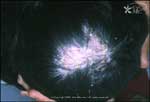|
|
 |
Ringworm of the scalp
|
 |

Abnormal |
| |
-
Tinea
capitis is a fungal infection of the scalp. It is usually seen only in children between the ages of 4 and 14 years, and is very rare in adults. It usually causes patchy hair loss and a flaky rash. Treatment is with anti-fungus shampoos and/or pills.
|
 |
- Those affected generally have patchy areas of hair loss. The hair is usually weak and breaks in the middle.
- The scalp is often red, itchy, and scaly in the area of the hair loss.
- Sometimes there may be little bumps
filled with pus.
|
 |
-
Tinea capitis is due to a fungal infection of the scalp.
|
 |
- Examination -- the doctor easily recognizes the typical appearance of the rash.
- The doctor may also scrape the rash and look and examine it under the microscope.
- Sometimes a culture of the rash may be needed to make the diagnosis.
- Rarely will a biopsy need to be done.
- If this diagnosis is suspected in an adult, he will need to be referred to a dermatologist, as it rarely occurs other than in children.
|
 |
- Treatment is often started with a selenium sulfide shampoo that is used every 1 to 3 days. This is combined with an oral anti-fungus medicine called Griseofulvin.
- Children are treated with Griseofulvin at a dose of 5 mg per kg of body weight per day, or approximately 125-250 mg/d. It is taken daily for 6 weeks. The child is then re-evaluated and the rash re-examined.
- Continue medication for 2 weeks after the rash shows no evidence of the fungus.
|
 | |
|
 |
- A severe form of tinea capitis, called kerion formation, can occur and lead to a lot of scarring of the scalp as well as hair loss. This needs to be treated by a dermatologist.
- Griseofulvin can cause birth defects and should not be taken by women who are pregnant or by those trying to become pregnant.
- All women who are going to take Griseofulvin need to take a pregnancy test before starting the medicine.
- Women on birth control pills need to be careful because Griseofulvin can decrease the effectiveness of the pills. Therefore, all women taking Griseofulvin need to be using two forms of contraception.
|
| | |
If you want your friend to read or know about this article, Click here
 |
|
|

